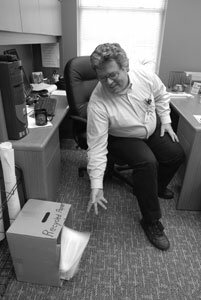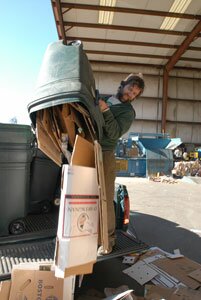COVER- (Re)Cycle of life: We want to believe

We love to recycle. We feel soooo virtuous recycling and saving the planet– even when it doesn't make economic (or perhaps even environmental) sense. Consider:
– At the Ivy Landfill, glass bottles dutifully collected by trying-to-be-helpful citizens lie in a heap waiting to be crushed and used as a substitute for gravel in roads at the site. The bottom has dropped out of the glass market, and even road-fill is preferable to just straight-out burying it.
– Charlottesville citizens can now add cardboard and plastic to their curbside recycling bins. Cardboard is a moneymaker, but you have to pay to get rid of plastic, so the city coughs up $1,800 a month to have those two-liter Coke bottles hauled away– in the name of environmental stewardship.
– At McIntire Recycling Center, a car a minute– that's 3,500 to 4,000 people a week– pulls up to deposit its contribution to saving the planet, even though that's a heckuva lot of single-occupancy vehicles burning petroleum and spewing hydrocarbons in the name of recycling.
– Woolen Mills is a green-lovin', environmentally correct neighborhood– until it comes to the Moore's Creek Wastewater Facility. The facility had great success composting the area's human waste, especially for local gardeners. But it stinks, and so we'll now pay $450,000 a year to ship the feces from our backyards to Richmond for composting.
"Fifteen years ago, the belief was that these programs would pay for themselves," says Tom Kinnaman, author of Why Do Municipalities Recycle? "It was shocking news 10 years ago that recycling is expensive. We thought it was a windfall."
It was in 1996 that the New York Times Sunday Magazine rocked conventional wisdom with a cover story blurbed, "What a waste." The story, "Recycling Is Garbage," by John Tierney, claimed that "rinsing out tuna cans and tying up newspapers may make you feel virtuous, but recycling could be America's most wasteful activity."
What's the state of recycling here, and how much does it cost us? The Hook takes a look and finds it's expensive– but we don't care.
Charlottesville v. Albemarle
Which local government is the most willing to put its citizens' money where its recycling bin is? Charlottesville clearly wins that challenge, ponying up $327,000 a year for curbside recycling, according to public works director Judith Mueller. That's on top of the $250,000 the city pays the Rivanna Solid Waste Authority to subsidize recycling. On February 5, Charlottesville added the aforementioned cardboard and plastic pickup.
"It certainly is a convenience to our customers," says Mueller. "It's a huge, huge advantage to downtown businesses," which generate a lot of cardboard.
Mueller is aware that plastic is a money-loser, but she thinks the cardboard will offset the cost– a loss leader, so to speak. "For a lot of customers, it will mean a lower trash bill because they can recycle what had been thrown away," she predicts.
"I personally think it makes sense," says Mueller of the expansion. "City Council is very committed."
The addition is part of the Mayor's Climate Agreement, signed last year by Mayor David Brown. "We're looking at ways we can change our practices internally and encourage externally some better environmental stewardship," says city spokesman Ric Barrick.
Albemarle residents use private carriers to haul their garbage away, and the county formerly required all haulers to pick up glass, plastic, and aluminum in convenient blue bags.
But Albemarle ditched the blue-bag curbside recycling program in 2003 when it decided it couldn't afford to pay $100,000 to subsidize a program that often sent glass and plastics to the landfill anyway.
The Board of Supervisors voices commitment to recycling, but, according to Chairman Ken Boyd, "It's not a high priority."
Albemarle spends a modest $45,000 a year on activities such as hazardous household waste and bulky waste amnesty days at the Ivy landfill (official name: Ivy Materials Utilization Center). The county also springs for two newspaper recycling bins at Sam's Club on Seminole Trail and by Rose's in the Pantops Shopping Center. And the county has budgeted for more comprehensive recycling drop-off centers, with the first to be in Crozet. Yet the future of curbside recycling in a county three-fourths the size of Rhode Island looks cloudy.
"We're still scratching our heads," says Mark Graham, Albemarle's community development director. "The Board as a whole expects us to come up with an effective plan rather than pay lip service to recycling. That's the tough part."
Private trash haulers in the county are still required to pick up newspapers, but unless residents asks for that service, they may not get it. Allied Waste, the largest hauler in the county, did not respond to the Hook's request for the cost of dispatching a truck to pick up newspapers.
And while Albemarle requires haulers to pick up newspapers, it doesn't offer the option of recycling aluminum cans. Aluminum– currently fetching 40 cents a pound at Coiner's Scrap Metal– is the most valuable commodity by weight in the recycling spectrum, but the quantities available at each household rarely justify a pickup.
"There are diminishing returns," says Graham. "When you pick up a half pound of aluminum cans, the cost of the pickup is way more. The amount collected versus the cost of getting it is all out of whack. That's why we're looking at one-stop drop-off sites."
RWSA
The city and county join forces in the Rivanna Solid Waste Authority, which operates three recycling-centric locations:
• the McIntire Recycling Center,
• the Ivy Materials Utilization Center (the former landfill), and
• the Paper Sort in back of Coiner's Scrap Metal.
Rivanna earns $269,000 in recycling revenues, but the programs cost $634,000 annually, for a $365,000 deficit.
"We provide the service free of charge," says the Authority's executive director, Tom Frederick. "No one is paying for it. We're paying for staff, trucks, and fuel."
This summer, RWSA hopes to solicit citizens' input to determine what they want– and what they're willing to pay for, he says.
But it's not all about dollars and cents. "One of the reasons we continue to do that is the public is asking for that service, and for the environmental benefit," he says.
It costs $66 a ton to landfill trash. Bottom-line recycling costs don't include the savings realized from keeping those materials out of the landfill, according to Frederick. Rivanna recycling programs kept 5,000 tons out of landfill in 2005, and he estimates another 37,000 tons were diverted by other businesses that do recycling, such as Coiner's.
"You have to ask those questions," says Frederick. "You're extending the life of the landfill– people bring us materials they'd have to pay to landfill."
The leak-plagued Ivy landfill stopped accepting trash in 2001. Now the city and county's trash is shipped to neighboring counties such as Fluvanna– and beyond.
The jewel in the Rivanna Solid Waste Authority crown is the McIntire Recycling Center, where Bruce Edmonds is the dedicated operations manager.
"Earth Day 1970 as a junior high student, I got the call," remembers Edmonds.
Last year, McIntire and the Paper Sort recycled 10 million pounds, he says.
Paper is the most profitable material, and large volumes of the stuff are sorted into four types: newspaper, cardboard, mixed paper (including cereal boxes), and office paper. Citizens can toss magazines and catalogs in the newspaper bin.
"That's unheard of," says an obviously proud Edmonds, adding that this is the only place in the area that recycles telephone books.
In 2002, such generous policies were threatened by a $250,000 budget shortfall. RWSA considered dumping glass, plastics, textiles, and phone books, and charging $1 a car to recycle. Public outcry halted those dire measures.
When the county stopped its curbside recycling, many Albemarleans channeled their recycling impulses to McIntire. But the shortfall remains.
Mr. Jefferson's recycling
Virginia mandates that state institutions recycle 25 percent of their solid waste. UVA claims a hefty 41 percent is recycled– 5,400 tons in 2005.
"When I came into this department in 1994, it cost us money to recycle– $350,000 or more," recalls Cheryl Gomez, UVA's director of utilities and energy.
These days, she says, "It costs the university $21 a ton less to recycle than to landfill."
Gomez attributes the benefit to good contractors. UVA uses a Madison Heights-based company called PSD Bryant and earns $11,500 a month from aluminum, paper, cardboard and scrap metal– money that pays for deficit-producing plastic and glass, she says. By baling up its aluminum, UVA earns 87 cents a pound on cans, 47 cents more than the loose can rate at Coiner's.
In addition to aluminium cans, the university bales up other materials for recycling, including plastic, despite what might be seen as meager returns: the 4.61 tons UVA recycled in December brought in $92.10.
UVA is so onboard with recycling, it came as a shock that an organization called the Sustainable Endowments Institute, founded in 2005, recently gave the university a D+ in its ranking of college sustainability. In particular, the university got low marks for not having a local supply of food, for not making endowment holdings public, and for not offering public comment about such holdings.
University spokeswoman Carol Wood fired off a letter expressing surprise– and questioning the organization's methodology. "We believe sustainability is a critically important issue– both locally here in Charlottesville and globally," wrote Wood, "and we are dedicated to becoming a model of sustainability."
"I don't know what went into their methodology," echoes Gomez. "I was very surprised at the marks on energy and recycling. She notes that the university has won 13 awards for its energy program and 14 for recycling. "Some of these are from the EPA," she adds.
Corporate recycling
Tom Frederick touts the Rivanna Solid Waste Authority's recycling partnership with local businesses. Crutchfield now accepts electronics for recycling at its Rio Hill store. The retailer claims it was inspired by the need to dispose of its own electronic waste.
"We did not do this to make money," says Jude DeFrank at Crutchfield. "Everything we do as a company we try to do in an environmentally friendly fashion. And most likely, if it has a plug, we can recycle it."
DeFrank lists refrigerators and dehumidifiers among the items Crutchfield accepts. The cost depends on the size, but citizens can offload old computers for $13– $8 for the CPU and $5 for the monitor. Crutchfield takes cellphones and old rechargeable batteries for free, DeFrank says.
Since August 2006, the company has recycled 27.5 tons of electronics. "It's a constant flow," DeFrank explains. "We're surprised." And how much does that environmental d0-gooding cost Crutchfield?
"We don't look at it from that perspective," he says. "We look at it as what should be done."
The company's corporate environmentalism extends beyond electronics. "We encourage employees not to use styrofoam cups," DeFrank says. Styrofoam has become a bete noir material because it isn't biodegradable. "Everyone has their own cup," DeFrank says.
And yet there's debate on the environmental wisdom of styrofoam versus the impact of using hot water to wash china mugs over and over again (remember the drought of 2002 when restaurants went to paper?). Winston Porter– the man who in the '80s devised the EPA's national goal of 25 percent recycling of all solid waste– tosses his styrofoam cups in the trash can.
Sensible recycling
Porter thought 25 percent was a goal the nation could reach, and, in fact, it inched up, he says, to 32 percent in the mid-'90s.
Porter, who now runs the Waste Policy Center in Leesburg, questions cities like Seattle that claim to be recycling 50 percent. He says there's political pressure to reach those numbers, so they may be including scrap steel and compost in the totals.
"And while I'm all for composting, it's a very low-value product," says Porter, "not like aluminum cans."
The Rivanna Solid Waste Authority included 10,000 tons of composted biosolids from the Moore's Creek facility in its total area estimate of 47,000 recycled tons and 31 percent recycling rate for 2005.
It costs Rivanna $250,000 to compost, but it earned $110,000 from sale of the organic matter before February 5, when Charlottesville and Albemarle's biosolids began being diverted to Environmental Solutions in Richmond for composting. The contract for that service costs $450,000– and there will be no compost revenue.
"There are two reasons to recycle," says Porter. "One, the economic incentive. And two, to keep more hazardous materials out of the landfill– such as tires, used oil, and batteries." He sees large offices as current recycling gold mines with their tons of valuable paper.
"There's a point, if you're running around with trucks to catch the last smidgen, you're using petroleum and creating emissions," says Porter to explain why he throws his styrofoam cups in the trash. "I decided it was not worth it to get in my car to dispose of a half dozen cups."
And then there's glass. Gone are the days of sorting into brown, green, and clear. It all goes into one bin and then out to the landfill.
Both Frederick and Edmonds at Rivanna Solid Waste Authority say they're actively seeking alternative uses for glass, such as in building materials. Meanwhile, the glass at Ivy landfill waits to be crushed and used in road beds, as does UVA's at the Fluvanna landfill.
"I have a hard time calling that recycling when you're crushing it and replacing dirt," says Albemarle's Mark Graham.
But what's so wrong with just putting glass and plastics straight into a landfill?
A common, save-the-landfill theme emerges from proponents of recycling at any cost. But plastic and glass, unlike toxic waste, are not hurting anything sitting in a landfill, other experts contend.
Once upon a time, every town had a dump. Today there are fewer landfills, but they're bigger, safer, and better hidden. And most of what they bury isn't household waste. Eighty percent of the material in landfills is construction debris versus 20 percent household, according to Bucknell prof Tom Kinnaman, who earned his PhD in economics at UVA.
The idea that recycling pays for itself is "unreal," says Kinnaman. And the budgeting outlay to recycle, he says, is twice what it costs to landfill waste.
"That doesn't mean we shouldn't be doing it," he says. "Economists would say people are deriving utility from that activity." Kinnaman points out that fire departments and city parks don't pay for themselves, either.
The municipal subsidy "means we might have less money for parks, fire departments and schools, but if they'd rather have this activity, who are we to say?" he asks. "People in Charlottesville love it. This is a democracy."
The urge to recycle remains strong, especially since disasters like 9-11 and Hurricane Katrina. People want to help, and that sentiment has been channeled into recycling, says Kinnaman.
"But if you have this great desire to help the environment, even better than recycling, stop driving so much," he says. "Go ahead and drink from that plastic bottle and throw it away, and then walk to work."
The danger with our love affair with recycling is that many people "feel they've done their part," says Kinnaman. "And then it's okay to drive their car or turn up their thermostat."

Judith Mueller, Charlottesville chief of public works, says some trash bills will be less now that the city is picking up cardboard for recycling.
PHOTO BY JEN FARIELLO

Albemarle director of community development Mark Graham is looking for a way to satisfy citizens' desire to recycle– without paying through the nose to do so.
PHOTO BY JEN FARIELLO

The big money in recycling: paper. Ryan Wender helps turn cardboard into gold at Rivanna Solid Waste Authority's Paper Sort.
PHOTO BY JEN FARIELLO

Rivanna Solid Waste Authority Tom Frederick understands the desire to recycle, and this summer he'll host a series of public meetings to find out what people want and what they're willing to pay.
FILE PHOTO BY JEN FARIELLO

Bruce Edmonds runs the McIntire Recycling Center, and notes that since 2000, no paper-recycling trucks from there have been rejected for contaminated loads. "That's a huge thing," he says.
PHOTO BY JEN FARIELLO

Bottles collected at McIntire Recycling Center go the Ivy Landfill, where they will be crushed and used in road beds at the landfill until a better idea comes along.
PHOTO BY NATHAN WEST
SIDEBAR- The cost of recycling: You do the math
What's that stack of newspapers worth on the open market? How much does local government pay to subsidize recycling?
The envelope, please.
Rivanna Solid Waste Authority recycling revenue
Newspaper $80/ton
Cardboard (baled) $70/ton
Office paper $82.50/ton
Mixed paper (baled) $45/ton
Aluminum cans $800/ton (40¢/pound)
UVA recycling revenue
Newspaper & junk mail mixed $4.50/ton
Cardboard (picked up) $35/ton
Cardboard (delivered) $56/ton
White paper $165/ton
Office paper mixed $91/ton
Aluminum cans (baled) $1,740/ton (87¢/pound)
Rivanna Solid Waste Authority balance sheet
Recycling cost: $634,000
Recycling revenue: $269,000
Recycling tonnage 5,000
Recycling rate 31 percent
Charlottesville expenditures
Recycling $326,664
RWSA contribution $250,000
Albemarle expenditures
Recycling $45,000
RWSA contribution $650,000
#